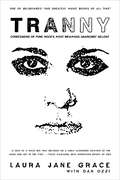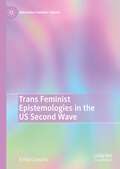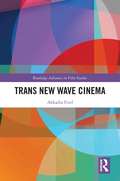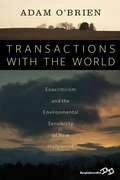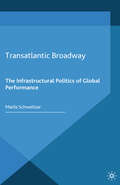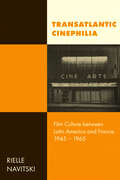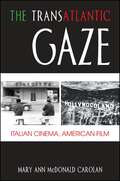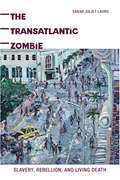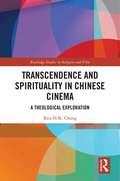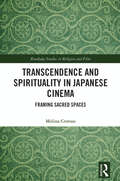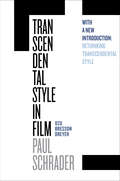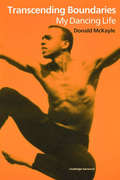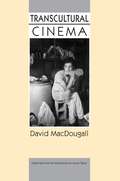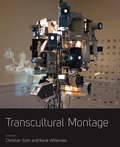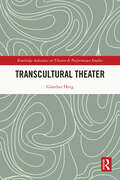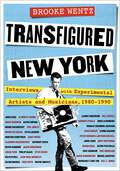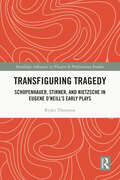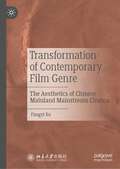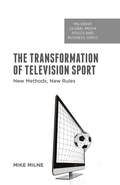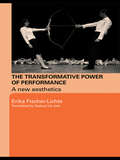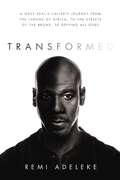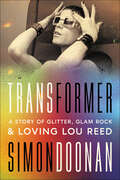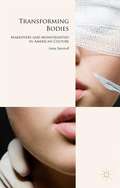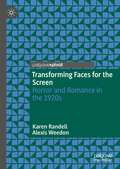- Table View
- List View
Tranny: Confessions of Punk Rock's Most Infamous Anarchist Sellout
by Dan Ozzi Laura Jane GraceONE OF BILLBOARD'S "100 GREATEST MUSIC BOOKS OF ALL TIME"The provocative transgender advocate and lead singer of the punk rock band Against Me! provides a searing account of her search for identity and her true self. It began in a bedroom in Naples, Florida, when a misbehaving punk teenager named Tom Gabel, armed with nothing but an acoustic guitar and a headful of anarchist politics, landed on a riff. Gabel formed Against Me! and rocketed the band from its scrappy beginnings-banging on a drum kit made of pickle buckets-to a major-label powerhouse that critics have called this generation's The Clash. Since its inception in 1997, Against Me! has been one of punk's most influential modern bands, but also one of its most divisive. With every notch the four-piece climbed in their career, they gained new fans while infuriating their old ones. They suffered legal woes, a revolving door of drummers, and a horde of angry, militant punks who called them "sellouts" and tried to sabotage their shows at every turn. But underneath the public turmoil, something much greater occupied Gabel-a secret kept for 30 years, only acknowledged in the scrawled-out pages of personal journals and hidden in lyrics. Through a troubled childhood, delinquency, and struggles with drugs, Gabel was on a punishing search for identity. Not until May of 2012 did a Rolling Stone profile finally reveal it: Gabel is a transsexual, and would from then on be living as a woman under the name Laura Jane Grace. Tranny is the intimate story of Against Me!'s enigmatic founder, weaving the narrative of the band's history, as well as Grace's, with dozens of never-before-seen entries from the piles of journals Grace kept. More than a typical music memoir about sex, drugs, and rock 'n' roll-although it certainly has plenty of that-Tranny is an inside look at one of the most remarkable stories in the history of rock.
Trans Feminist Epistemologies in the US Second Wave (Breaking Feminist Waves)
by Emily CousensWhy do “second wave” and “trans feminism” rarely get considered together? Challenging the idea that trans feminism is antagonistic to, or arrived after, second wave feminism, Emily Cousens re-orients trans epistemologies as crucial sites of second wave feminist theorising. By revisiting the contributions of trans individuals writing in underground print publications, as well as the more well-known arguments of Andrea Dworkin, this book demonstrates that valuable yet overlooked trans feminist philosophies of sex and gender were present throughout the US second wave. It argues that not only were these trans feminist epistemologies an important component of second wave feminism's knowledge production, but that this period has an unacknowledged trans feminist legacy.
Trans New Wave Cinema (Routledge Advances in Film Studies)
by Akkadia FordThis book presents a critical cultural study of the Trans New Wave as a cinematic genre and explores its emergence in the twenty-first century. Drawing on a diverse range of texts, the cultural, social, aesthetic and ethical implications of the genre are placed within the context of rapidly changing understandings of gender diversity. From the cinematic borderlands of independent film festivals to wider public recognition via digital technologies, the genre encompasses a diverse range of texts from short films, documentaries, experimental films, to feature films and narratives that range across life histories, narratives and themes. The book presents transliteracy as an original theoretical approach to reading film representations of the Trans New Wave, and combines it with a new theoretical concept of cinematic ethnogenesis to investigate how the genre emerged from specific communities and the reciprocal interaction of audiences and texts. This interdisciplinary volume engages with contemporary issues of gender diversity, transgender studies, screen and media studies and film festival studies, and as such will be of great interest to scholars working in these fields and in media and cultural studies more generally.
Transactions with the World: Ecocriticism and the Environmental Sensibility of New Hollywood
by Adam O'BrienIn their bold experimentation and bracing engagement with culture and politics, the "New Hollywood" films of the late 1960s and early 1970s are justly celebrated contributions to American cinematic history. Relatively unexplored, however, has been the profound environmental sensibility that characterized movies such as The Wild Bunch, Chinatown, and Nashville. This brisk and engaging study explores how many hallmarks of New Hollywood filmmaking, such as the increased reliance on location shooting and the rejection of American self-mythologizing, made the era such a vividly "grounded" cinematic moment. Synthesizing a range of narrative, aesthetic, and ecocritical theories, it offers a genuinely fresh perspective on one of the most studied periods in film history.
Transatlantic Broadway: The Infrastructural Politics of Global Performance (Transnational Theatre Histories)
by M. SchweitzerTransatlantic Broadway traces the infrastructural networks and technological advances that supported the globalization of popular entertainment in the pre-World War I period, with a specific focus on the production and performance of Broadway as physical space, dream factory, and glorious machine.
Transatlantic Cinephilia: Film Culture between Latin America and France, 1945–1965 (Cinema Cultures in Contact #6)
by Rielle NavitskiIn the two decades after World War II, a vibrant cultural infrastructure of cineclubs, archives, festivals, and film schools took shape in Latin America through the labor of film enthusiasts who often worked in concert with French and France-based organizations. In promoting the emerging concept and practice of art cinema, these film-related institutions advanced geopolitical and class interests simultaneously in a polarized Cold War climate. Seeking to sharpen viewers' critical faculties as a safeguard against ideological extremes, institutions of film culture lent prestige to Latin America's growing middle classes and capitalized on official and unofficial efforts to boost the circulation of French cinema, enhancing the nation's soft power in the wake of military defeat and occupation. As the first book-length, transnational analysis of postwar Latin American film culture, Transatlantic Cinephilia deepens our understanding of how institutional networks have nurtured alternative and nontheatrical cinemas.
The Transatlantic Gaze: Italian Cinema, American Film (SUNY series in Italian/American Culture)
by Mary Ann McDonald CarolanIn The Transatlantic Gaze, Mary Ann McDonald Carolan documents the sustained and profound artistic impact of Italian directors, actors, and screenwriters on American film. Working across a variety of genres, including neorealism, comedy, the Western, and the art film, Carolan explores how and why American directors from Woody Allen to Quentin Tarantino have adapted certain Italian trademark techniques and motifs. Allen's To Rome with Love (2012), for example, is an homage to the genius of Italian filmmakers, and to Federico Fellini in particular, whose Lo sceicco bianco/The White Sheik (1952) also resonates with Allen's The Purple Rose of Cairo (1985) as well as with Neil LaBute's Nurse Betty (2000). Tarantino's Kill Bill saga (2003, 2004) plays off elements of Sergio Leone's spaghetti Western C'era una volta il West/Once Upon a Time in the West (1968), a transatlantic conversation about the Western that continues in Tarantino's Oscar-winning Django Unchained (2012). Lee Daniels's Precious (2009) and Spike Lee's Miracle at St. Anna (2008), meanwhile, demonstrate that the neorealism of Roberto Rossellini and Vittorio De Sica, which arose from the political and economic exigencies of postwar Italy, is an effective vehicle for critiquing social issues such as poverty and racism in a contemporary American context. The book concludes with an examination of American remakes of popular Italian films, a comparison that offers insight into the similarities and differences between the two cultures and the transformations in genre, both subtle and obvious, that underlie this form of cross-cultural exchange.
The Transatlantic Zombie: Slavery, Rebellion, and Living Death
by Sarah J. LauroOur most modern monster and perhaps our most American, the zombie that is so prevalent in popular culture today has its roots in African soul capture mythologies. The Transatlantic Zombie provides a more complete history of the zombie than has ever been told, explaining how the myth's migration to the New World was facilitated by the transatlantic slave trade, and reveals the real-world import of storytelling, reminding us of the power of myths and mythmaking, and the high stakes of appropriation and homage. Beginning with an account of a probable ancestor of the zombie found in the Kongolese and Angolan regions of seventeenth-century Africa and ending with a description of the way, in contemporary culture, new media are used to facilitate zombie-themed events, Sarah Juliet Lauro plots the zombie's cultural significance through Caribbean literature, Haitian folklore, and American literature, film, and the visual arts. The zombie entered US consciousness through the American occupation of Haiti, the site of an eighteenth-century slave rebellion that became a war for independence, thus making the figuration of living death inseparable from its resonances with both slavery and rebellion. Lauro bridges African mythology and US mainstream culture by articulating the ethical complications of the zombie's invocation as a cultural conquest that was rebranded for the American cinema. As The Transatlantic Zombie shows, the zombie is not merely a bogeyman representing the ills of modern society, but a battleground over which a cultural war has been fought between the imperial urge to absorb exotic, threatening elements, and the originary, Afro-disaporic culture's preservation through a strategy of mythic combat.
Transcendence and Spirituality in Chinese Cinema: A Theological Exploration (Routledge Studies in Religion and Film)
by Kris H.K ChongThis book provides a framework by which a global audience might think theologically about contemporary films produced in mainland China by Chinese directors. Up to this point the academic discipline of Christian theology and film has focussed predominantly on Western cinema, and as a result, has missed out the potential insights offered by Chinese spirituality on film. Mainland Chinese films, produced within the nation’s social structure, offer an excellent lingua franca of China. Illuminating the spiritual imagination of Chinese filmmakers and their yearning for transcendence, the book uses Richard A. Blake’s concept of afterimage to analyse the potential theological implications of their films. It then brings Jürgen Moltmann’s "immanent-transcendence" and Robert K. Johnston’s "God’s wider Presence" into conversation with Confucianist and Daoist ideas of there being, spirituality-speaking, "More in Life than Meets the Eye" than simply material existence. This all combines to move beyond film and allow for a Western audience to gain a new perspective on Chinese culture and traditions. One that uses familiar Western terms, while avoiding the imposition of a Western mindset. This is a new perspective on cinema, religion and Chinese culture that will be of keen interest to scholars of Religion and Film, Religious Studies, Theology, Sociology of Religion and Chinese Studies.
Transcendence and Spirituality in Japanese Cinema: Framing Sacred Spaces (Routledge Studies in Religion and Film)
by Melissa M. CroteauThis book explores significant representations of Shinto and Buddhist sacred space, spiritual symbols, and religious concepts that are embedded in the secular framework of Japanese films aimed at general audiences in Japan and globally. These cinematic masterpieces by directors Akira Kurosawa, Hayao Miyazaki, Hirokazu Kore-eda, and Makoto Shinkai operate as expressions of and, potentially, catalysts for transcendence of various kinds, particularly during the Heisei era (1989-2019), when Japan experienced severe economic hardship and devastating natural disasters. The book’s approach to aesthetics and religion employs the multifaceted concepts of ma (structuring intervals; liminal space-time), kū (emptiness; sky), mono no aware (compassionate sensibility; resigned sadness), and musubi (generative interconnection), examining the dynamic, evolving nature of these ancient principles that are at once spiritual, aesthetic, and philosophical. Scholars and enthusiasts of Japanese cinema (live action and anime), religion and film, cinematic aesthetics, and of the relationship between East Asian religions and the arts will find fresh perspectives on these in this book, which moves beyond conventional notions of transcendental style and essentialized approaches to the multivalent richness of Japanese aesthetics.
Transcendental Style in Film: Ozu, Bresson, Dreyer
by Paul SchraderWith a new introduction, acclaimed director and screenwriter Paul Schrader revisits and updates his contemplation of slow cinema over the past fifty years. Unlike the style of psychological realism, which dominates film, the transcendental style expresses a spiritual state by means of austere camerawork, acting devoid of self-consciousness, and editing that avoids editorial comment. This seminal text analyzes the film style of three great directors—Yasujiro Ozu, Robert Bresson, and Carl Dreyer—and posits a common dramatic language used by these artists from divergent cultures. The new edition updates Schrader’s theoretical framework and extends his theory to the works of Andrei Tarkovsky (Russia), Béla Tarr (Hungary), Theo Angelopoulos (Greece), and Nuri Bilge Ceylan (Turkey), among others. This key work by one of our most searching directors and writers is widely cited and used in film and art classes. With evocative prose and nimble associations, Schrader consistently urges readers and viewers alike to keep exploring the world of the art film.
Transcending Boundaries: My Dancing Life (Choreography And Dance Studies #Vol. 22)
by Donald McKayle"First Published in 2002, Routledge is an imprint of Taylor & Francis, an informa company."
Transcultural Cinema
by David MacDougallDavid MacDougall is a pivotal figure in the development of ethnographic cinema and visual anthropology. As a filmmaker, he has directed in Africa, Australia, India, and Europe. His prize-winning films (many made jointly with his wife, Judith MacDougall) include The Wedding Camels, Lorang's Way, To Live with Herds, A Wife among Wives, Takeover, PhotoWallahs, and Tempus de Baristas. As a theorist, he articulates central issues in the relation of film to anthropology, and is one of the few documentary filmmakers who writes extensively on these concerns. The essays collected here address, for instance, the difference between films and written texts and between the position of the filmmaker and that of the anthropological writer.In fact, these works provide an overview of the history of visual anthropology, as well as commentaries on specific subjects, such as point-of-view and subjectivity, reflexivity, the use of subtitles, and the role of the cinema subject. Refreshingly free of jargon, each piece belongs very much to the tradition of the essay in its personal engagement with exploring difficult issues. The author ultimately disputes the view that ethnographic filmmaking is merely a visual form of anthropology, maintaining instead that it is a radical anthropological practice, which challenges many of the basic assumptions of the discipline of anthropology itself. Although influential among filmmakers and critics, some of these essays were published in small journals and have been until now difficult to find. The three longest pieces, including the title essay, are new.
Transcultural Montage
by Rane Willerslev Christian SuhrThe disruptive power of montage has often been regarded as a threat to scholarly representations of the social world. This volume asserts the opposite: that the destabilization of commonsense perception is the very precondition for transcending social and cultural categories. The contributors--anthropologists, filmmakers, photographers, and curators--explore the use of montage as a heuristic tool for comparative analysis in anthropological writing, film, and exhibition making. Exploring phenomena such as human perception, memory, visuality, ritual, time, and globalization, they apply montage to restructure our basic understanding of social reality. Furthermore, as George E. Marcus suggests in the afterword, the power of montage that this volume exposes lies in its ability to open the very "combustion chamber" of social theory by juxtaposing one's claims to knowledge with the path undertaken to arrive at those claims.
Transcultural Theater (Routledge Advances in Theatre & Performance Studies)
by Günther HeegTranscultural Theater outlines the idea of a transcultural theater as enabling an approximation to and an interaction with the foreign and the alien. In consideration of the allure of fundamentalist and populist movements that promote the development and practices of xenophobia worldwide, this book makes a powerful plea for the art of theater as a medium of conviviality with (the) foreign(er) that should not be underestimated. This study contributes to transcultural experience, artistic practice, and education in the medium of theater. The book’s investigation extends far into space and time and pays particular attention to the relationship between aesthetic experience, artistic practice, and academic representation. This book is for scholars and students as well as for all those working in the cultural field, especially in the field of cultural transfer.
Transfigured New York: Interviews with Experimental Artists and Musicians, 1980-1990 (Columbiana)
by Brooke WentzTransfigured New York presents conversations with iconic, genre-bending artists who shaped the sounds of experimental movements like no wave, avant-jazz, and electronic music. As an undergrad in the 1980s, Brooke Wentz hosted the show Transfigured Night on Columbia University’s WKCR-FM, discussing art and ideas with avant-garde music luminaries. She unearths these candid interviews—heard before only when first broadcast—from cassettes and reel-to-reel tapes, letting readers today feel the excitement and creative energy of the 1980s New York underground scene.Musicians and artists, now icons of their craft, tell their stories and share their thoughts about the creative process, capturing the ambition and energy that animated their work. Legends in the making like Bill Frisell, Philip Glass, and Laurie Anderson convey what it was like to be a struggling artist in 1980s New York, when the city was alive with possibilities. Others who were well known at the time, including John Cage, La Monte Young, and Ravi Shankar, advocate for their distinctive ideas about art and open up about their creative lives.Featuring an astonishing range of interviewees—Morton Subotnick, Joan Tower, Steve Reich, Glenn Branca, Joan La Barbara, Living Colour, Arthur Russell, John Lurie, Eric Bogosian, Bill T. Jones, and many more—Transfigured New York provides new insight into the city’s cultural landscape in this era. It is a one-of-a-kind account of one of the most exhilarating and inventive periods for art and culture in New York City’s history.
Transfiguring Tragedy: Schopenhauer, Stirner, and Nietzsche in Eugene O’Neill’s Early Plays (ISSN)
by Ryder ThorntonThis book demonstrates Eugene O’Neill’s use of philosophy in the early period of his work and provides analyses of selected works from that era, concluding with The Hairy Ape, completed in 1921, as an illustration of the mastery he had achieved in dramatizing key concepts of philosophy.Analyses of one-act and full-length plays from 1913 to 1921 reveal the influence of the three philosophers and establish that O’Neill was fundamentally a philosophic playwright, even from his earliest dramatic sketches. Specific concepts from Schopenhauer, Stirner, and Nietzsche went into O’Neill’s shaping of character arcs, dramatic circumstances, symbology, and theme. Among them are Schopenhauer’s concept of will and representation, Stirner’s notion of possession, and Nietzsche’s principle of the Apollonian–Dionysian duality. These ideas were foundational to O’Neill’s construction of tragic irony apparent in his early period plays. The critical concepts of these three philosophers are the major pathways in this study. However, such an approach inevitably reveals other layers of spiritual influence, such as Catholicism and Eastern philosophy, which are touched on in these analyses.This book is a much-needed introduction to philosophic concepts in Eugene O’Neill’s early work and would be of great interest to students and scholars in theatre studies and philosophy.
Transformation of Contemporary Film Genre: The Aesthetics of Chinese Mainland Mainstream Cinema
by Fangyi XuThis book is the first one focusing on Chinese mainstream films from a cross-disciplinary perspective. Based on case studies, it discusses three subgenres of mainland Chinese commercial mainstream films and offers an approach to studying the transformation of Chinese mainstream film within the theoretical frameworks of “genre theory” and “screenwriting method”. It helps professionals understand the genres and narratives of Chinese mainstream films, and also serves as a must-read for non-professionals interested in Chinese cinema.
The Transformation of Television Sport: New Methods, New Rules (Palgrave Global Media Policy and Business)
by M. MilneThe Transformation of Television Sport: New Methods, New Rules examines how developments in technology, broadcasting rights and regulation combine to determine what sport we see on television, where we can see it and what the final output looks and sounds like.
The Transformation of Television Sport: New Methods, New Rules (Palgrave Global Media Policy and Business)
by Mike MilneThe Transformation of Television Sport: New Methods, New Rules examines how developments in technology, broadcasting rights and regulation combine to determine what sport we see on television, where we can see it and what the final output looks and sounds like.
The Transformative Power of Performance: A New Aesthetics
by Erika Fischer-LichteIn this book, Erika Fischer-Lichte traces the emergence of performance as 'an art event' in its own right. In setting performance art on an equal footing with the traditional art object, she heralds a new aesthetics. The peculiar mode of experience that a performance provokes – blurring distinctions between artist and audience, body and mind, art and life – is here framed as the breeding ground for a new way of understanding performing arts, and through them even wider social and cultural processes. With an introduction by Marvin Carlson, this translation of the original Ästhetik des Performativen addresses key issues in performance art, experimental theatre and cultural performances to lay the ground for a new appreciation of the artistic event.
Transformed: A Navy SEAL’s Unlikely Journey from the Throne of Africa, to the Streets of the Bronx, to Defying All Odds
by Remi AdelekeWhat are the odds? Statistics tell us that African American males who grow up in a single-parent household are nine times more likely to drop out of high school and twenty times more likely to end up in prison than any other demographic. But what would it take for one young man not only to rise above those statistics but also become a Navy SEAL, actor, entrepreneur, writer, and successful husband and father?In Transformed, Remi Adeleke takes you back to stories from his childhood, from living as Nigerian royalty to losing his father early in life and being stripped financially of everything by the Nigerian government. He delves into being raised by a single mother in the Bronx and doesn’t shy away from his illegal activities as a young man that threatened to derail his future. At every turn, including throughout his naval career, Adeleke found a way to overcome the odds, even when it didn’t make sense. His is an inspiring story of true personal transformation.
Transformer: A Story of Glitter, Glam Rock, and Loving Lou Reed
by Simon DoonanIn this funny and poignant memoir and cultural history, the television personality, columnist, and author of Drag pays homage to Lou Reed’s groundbreaking album Transformer on its fiftieth anniversary and recalls its influence on his coming of age and coming out through glam rock.In November 1972, Lou Reed released his album, Transformer because he thought it was “dreary for gay people to have to listen to straight people’s love songs.” That groundbreaking idea echoed with the times. That same year, Sweden was the first country to legalize gender-affirming surgery, and San Francisco struck down employment discrimination based on sexual orientation.Sometimes an artistic creation perfectly aligns with a broader social and political history, and Transformer—with the songs “Walk on the Wild Side,” “Perfect Day,” and “Vicious”—perfectly captured its time. “Walk on the Wild Side” was banned on radio across the country but became a massive hit when young people threatened to boycott stations that would not play it. The album's cover featured a high-contrast image of Lou, flaunting a new mascara'd glamrock incarnation, shot by legend Mick Rock, thereby underscoring his intention to create "a gay album."In Transformer, Doonan tells the story of how Lou Reed came to make the album with the help of David Bowie, and places its creation within the course of Reed’s life. Doonan offers first-hand testimony of the album’s impact on the LGBTQ+ community, recalling how it transformed his own life as a 20-year-old working class kid from Reading, England, who had just discovered the joys of London Glam Rock and was sparked by the artistic freedom of Warhol’s The Factory. Transformer was a revelation—hearing Reed’s songs, Doonan understood how the world was changing for him and his friends.A poignant, personal addition to modern music and LGBTQ+ history, Transformer captures a pivotal moment when those long silenced were finally given a voice. As transgender icon Candy Darling, highlighted in his lyrics, told Reed, “It’s so nice to hear ourselves.”Transformer includes approximatively 16 pages of black-and-white and color photos.
Transforming Bodies
by Heike SteinhoffAt the turn of the twenty-first century, American media abound with images and narratives of bodily transformations. Transforming Bodies investigates how these representations have become key sites for the negotiation of power. Focusing on the representations of 'extreme' forms of somatic transformations, particularly cosmetic surgery, this book examines iconic popular cultural texts from diverse media and genres. The reality TV show The Swan, the TV drama series Nip/Tuck, Chuck Palahniuk's(post-)postmodern novels Invisible Monsters and Invisible Monsters Remix, and Scott Westerfeld's young adult fiction series Uglies are read as expressions of the heterogeneous biopolitical discourses that are articulated in the American mediascape. In contemporary American culture, representations of body transformations are often part of a makeover paradigm that presents bodies as 'beautiful,' 'individual' and 'improved' if they adhere to normative constructions of gender, sexuality, class, race/ethnicity, and able-bodiedness. However, Transforming Bodies demonstrates that a number of popular cultural texts take up narrative structures, representational strategies and ideological underpinnings of makeover culture in order to re-write them. These texts link makeovers to images, practices, and narratives of monstrosity and thereby challenge cultural norms. At the crossroads of American, cultural, literary, media, gender, queer, disability and governmentality studies, the book presentsa timely intervention into critical debates on body transformations and contemporary makeover culture.
Transforming Faces for the Screen: Horror and Romance in the 1920s
by Karen Randell Alexis WeedonThis book brings together research from medical and film archives to illustrate the cultural impact of film and literature in its relationship to the discourse of plastic surgery in the 1920s. This different take on reading the body after the First World War enables students of multiple disciplines, and readers interested in both Hollywood and post-war culture, to understand some of the complexities of medical interventions gained after the First World War and the way in which they filtered into the world of Hollywood film making. It also allows readers who may not be familiar with these two 1920s stars to access the films of Lon Chaney and the books and films of Elinor Glyn and gain new insights into 1920s visual culture. For ease of readership, the book is organised so that each of the main chapters focuses on a particular film (either Lon Chaney or Elinor Glyn). This is particularly useful for use in the classroom or for online education. Readers can refer to the film directly, aided by illustrations of frames from the films. This book tells the story of how two stars of Hollywood film transformed their character’s faces on screen through a close reading of three films in the 1920s. It reveals how they applied their embodied knowledge of surgery and surgical procedures to broaden their audience’s emotional and intellectual understanding of the treatment of deformity and disability.
